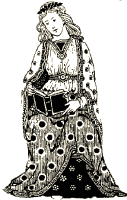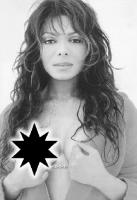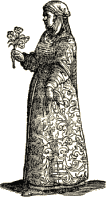The Trimaris Fashion Report

The Origins of Body Piercing
Piercing has ancient origins. The oldest mummified body in the world discovered in an Austrian glacier was found to have ear-piercing 7-11 mm in diameter. Nose piercing is mentioned in the Bible. In Genesis 24:22 Abraham gave a nose-ring to Rebekah, wife of his son Isaac. Nose piercing reached India in the 16th century and rapidly became accepted. Tongue piercing was popular with the elite of Aztec and Maya civilization; it was carried out as part of a religious ceremony of ritual blood letting, not to insert jewelry.

Justin reveals that Ms. Jackson is really an Ansteorran at heart.
Ancient Mesoamericans did pierce ears, nose, and lower lips for jewelry. Roman Centurions wore leather armor breast plates which were shaped to fit the body and rings were sometimes placed in these breastplates where the nipples appeared to be, the rings were used to hang a cape from. (This has led to the belief by some people that the actual nipples were pierced to hang a cape from, but anybody who has had their nipples pierced would tell you that this would be a very uncomfortable practice.) According to Hans Peter Duerr in "Dreamtime": In the middle of the 14th century, many women suddenly wore "such low necklines that you could see nearly half their breasts", and among the upper classes in the same century, Queen Isabella of Bavaria introduced the "garments of the grand neckline", where the dress was open to the navel. This fashion eventually led to the application of rouge to freely displayed nipples, those "little apples of paradise" and to placing diamond studded rings or small caps on them, even to piercing them and passing gold chains through them decorated with diamonds."
FASHION PLATES OF TRIMARIS:

Did you guys check out HL Richard MacKenzie and Lord Griffyn ap Owain? Dressed in a cotehardie of purple with a dagged hood and a houppeland of burgundy and dark grey, these guys were some serious eye candy to ogle. Not only that, they are two of the nicest guys in the kingdom (just don't tell them I told you so). Also sporting a lovely houppeland — and one of her many period hats — was Lady Beatrix. Q: How many period hats does she have? A: Enough to have a huge A&S display! Lady Mary Elizabeth Bracewell was looking lovely in a red and green velvet Italian Renaissance gown. Not only is that woman constantly working hard for our kingdom, she also looked great in that dress. Italian Renaissance is the best, I always say, but not like I'm partial or anything. OK, yes I am! Lady Ysabiau "Jolicouer" d'Avignon — handsome, talented and very versatile — looked like an Indian Princess in her tan and gold sari. And speaking of talented, have you heard her sing? I recommend it highly since she has one of the loveliest voices in this kingdom. So much in fact that she has three Bard Laureate accolades! Lady Ilyssa von Ritten looked like she was going a rovin' in her purple Persian.

And as I am wondering, as others may be as well, why there were "Viking Cows" in Coronation Court? If any of the ladies involved wishes to explain themselves, by all means drop me an e-mail here at The Quarter. We are all wondering why, oh why?!
FUNKY TUNIC LUAU! Don't forget to be at the Funky Tunic Luau Saturday night and join in the fun as we break in the new campsite. You know the most fashionable folk in the Knowne World will be there. Like me! Clear your schedule and be there too. You may find yourself reading about yourself in the next issue.
